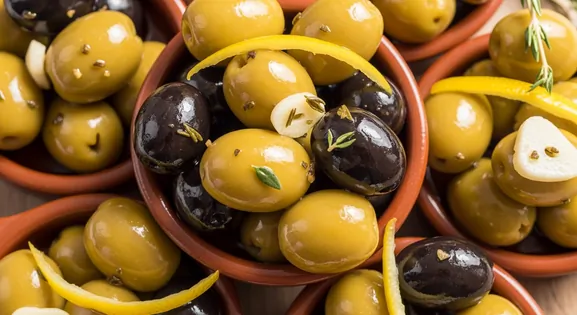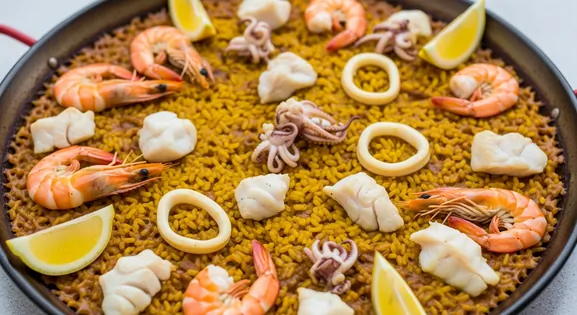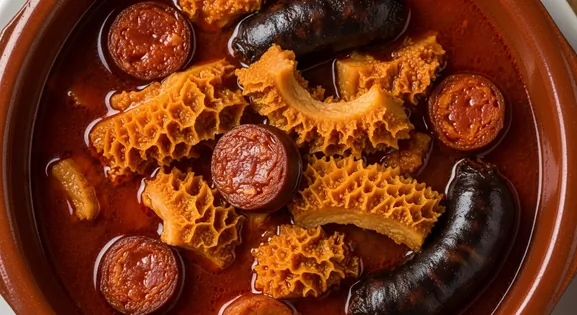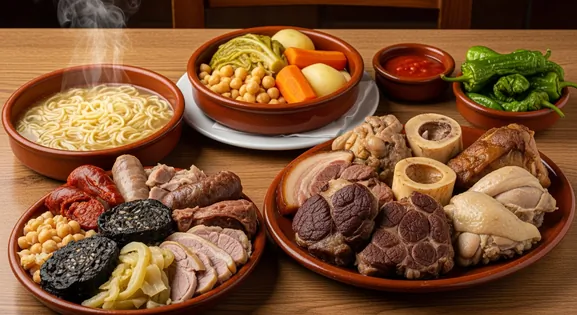Arroz Negro in Spain: A Complete Food Lover's Guide
Arroz Negro
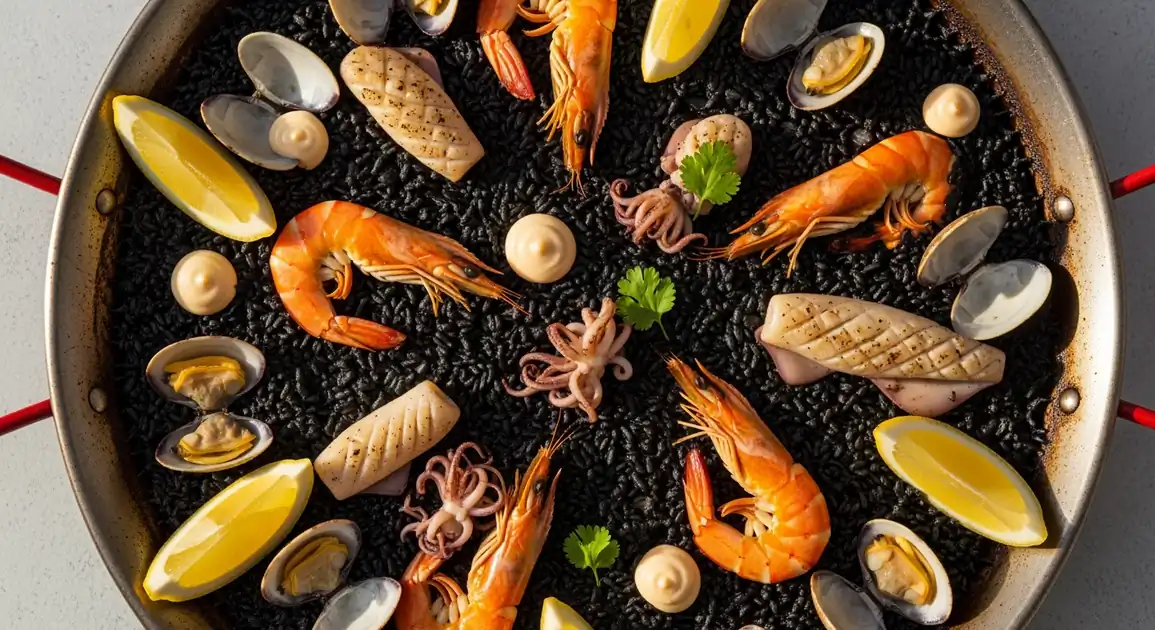
Understanding This Dish: An Introduction
Arroz Negro is a striking Spanish seafood rice dish, colored pitch-black from squid ink. Popular in coastal Mediterranean regions, particularly Valencia, this dish showcases plump short-grain rice cooked with sofrito (garlic, onion, tomato base), rich seafood stock, and fresh seafood including squid, cuttlefish, and often clams or prawns. The squid ink provides not just dramatic color but a subtle oceanic sweetness and complexity that distinguishes it from regular paella. Traditionally served with alioli (garlic mayonnaise) and lemon wedges, it offers a balance of rich umami flavors and brightness.
Deconstructing Arroz Negro (Black Rice): Ingredients and Method
Traditional Arroz Negro begins with a sofrito base of sautéed garlic, onions, and grated tomatoes in olive oil. Squid and cuttlefish are added and cooked until tender, then bomba rice (or other short-grain Spanish rice) is incorporated and briefly toasted. Squid or cuttlefish ink is dissolved into fish or seafood stock and added to the rice along with white wine and paprika. Additional seafood like prawns, mussels, or clams may be incorporated. Unlike some paellas, Arroz Negro is stirred occasionally during cooking to create a slightly creamier texture. After simmering for about 18-20 minutes, the rice should be al dente. The dish is then rested briefly before serving with freshly made alioli and lemon wedges. Properly cooked Arroz Negro should have a socarrat (crispy bottom layer) if cooked in a traditional wide, shallow paella pan.
Key Ingredients of Arroz Negro (Black Rice)
Bomba Rice
A short-grain, pearly white rice cultivated in Spain, known for absorbing liquid while remaining firm and distinct. Crucial for the desired texture.
Quality indicator: Look for plump, unbroken grains that absorb flavor without becoming mushy.
Squid Ink
The natural black pigment from squid or cuttlefish, coloring the rice and imparting a subtle, briny, oceanic flavor. It defines Arroz Negro.
Quality indicator: Ensure the ink is deep black and fully integrated, providing a uniform color without an unpleasant odor.
Fresh Seafood (Squid, Cuttlefish, Prawns)
A variety of fresh seafood, primarily squid and cuttlefish, provides the dish's core protein and maritime flavor, often complemented by prawns or clams.
Quality indicator: Seafood should be firm, translucent, and have a fresh, clean scent, not a strong fishy odor.
The Perfect Accompaniments
Alioli (Garlic Mayonnaise)
Sauce
A creamy, pungent garlic mayonnaise traditionally served alongside Arroz Negro. Its rich, tangy flavor cuts through the richness of the rice and seafood, offering a delightful contrast.
Dry White Wine (e.g., Albariño, Verdejo)
Beverage
A crisp, dry Spanish white wine complements the seafood and rich flavors of Arroz Negro without overpowering it. Its acidity helps cleanse the palate between bites.
Tracing the Roots of Arroz Negro (Black Rice)
Arroz Negro originated in coastal Spain, particularly in the Mediterranean regions of Valencia and Catalonia where seafood is abundant. While its exact origins are debated, it represents the evolution of paella and the ingenuity of Spanish coastal communities in creating distinctive rice dishes. Historically, fishermen would use all parts of their catch, including squid ink, which was discovered to impart both flavor and dramatic color. The dish gained popularity throughout the 20th century as a sophisticated alternative to traditional paella, showcasing the deep connection between Spanish cuisine and the Mediterranean Sea. Today, it's considered one of Spain's signature seafood rice dishes, served in homes and restaurants throughout the country's coastal regions.
Local Arroz Negro (Black Rice) Variations in Spain
Arroz Negro with Alioli Integrated
A modern variation where the alioli is mixed directly into the rice at the end of cooking rather than served on the side, creating a creamier, more homogenous dish.
Arroz Negro with Mixed Seafood
An abundant version featuring a wider variety of seafood including mussels, clams, prawns, and sometimes lobster, in addition to the traditional squid or cuttlefish.
Dry Arroz Negro
A drier version with less stock, more similar to traditional paella in texture, often with a pronounced socarrat (crispy bottom layer).
Creamy Arroz Negro
A creamier, risotto-like variation made with more liquid and often finished with butter or cream, popular in upscale restaurants.
Seafood Fideua Negra
A variation that uses short pasta (fideos) instead of rice, prepared with squid ink and similar seafood components.
A Traveler's Guide to Authenticity
What to Look For
-
Restaurants that prepare Arroz Negro to order (20-30 minute wait time)
Proper cooking time ensures rice absorbs flavors and reaches correct texture. Immediate serving indicates pre-cooked, reheated rice, a quality concern and a sign of less careful preparation.
-
Fresh seafood displays or specific daily seafood offerings
Venues displaying fresh catch or daily seafood typically use fresher ingredients, ensuring optimal freshness and quality.
-
Busy establishments with high customer turnover, especially with local patrons
Popular restaurants frequented by locals typically have fresher ingredients due to higher turnover and maintain better food quality standards.
-
Rice with distinct individual grains (moist but not mushy)
Properly cooked rice indicates attention to detail and correct cooking techniques, suggesting overall kitchen competence.
What to avoid
-
Arroz Negro served immediately after ordering
This indicates pre-cooked, reheated rice which presents both quality and freshness concerns, especially with seafood dishes.
-
Strong fishy smell from the dish
A strong fishy smell suggests old or poor quality seafood, which indicates compromised quality. Fresh seafood has a clean, pleasant aroma.
-
Empty restaurants during peak Spanish dining hours (2 PM - 4 PM for lunch)
Lack of customers during traditional meal times may indicate quality issues or insufficient turnover for fresh ingredients.
-
Tourist-focused restaurants with pictures of food and multiple international cuisines
Establishments catering exclusively to tourists often prioritize convenience over authenticity and may take shortcuts in preparation.
Explore Arroz Negro (Black Rice) in Detail: City Guides
Discover where to find the best Arroz Negro (Black Rice) and learn local tips in these cities:
Dietary Information
Dietary Information
Important Note for Travelers: Your safety is our priority. Below are the common allergens associated with the traditional preparation of this dish. However, recipes and ingredients can vary significantly between establishments. Always confirm all ingredients directly with the food vendor before ordering, especially if you have a severe allergy.
Potential Allergens
Dietary Suitability
How to Order Arroz Negro (Black Rice)
Frequently Asked Questions about Arroz Negro (Black Rice)
What is Arroz Negro?
Arroz Negro, or 'black rice,' is a Spanish seafood rice dish. Its distinctive black color comes from squid ink, which also imparts a subtle oceanic flavor. Made with short-grain rice and various seafood like squid, cuttlefish, and prawns, it's typically served with alioli and lemon. It offers a rich, maritime flavor profile and striking presentation.
Is Arroz Negro a quality choice?
Arroz Negro is a quality choice when prepared with fresh seafood and cooked thoroughly. Look for restaurants with good hygiene practices and high customer turnover that cook the dish to order. The squid ink is completely natural. Prioritize establishments near fishing ports or with displayed fresh seafood for optimal quality and freshness.
What does Arroz Negro taste like?
Arroz Negro offers a rich, savory umami flavor, blending the sea's brininess with earthy notes. The squid ink provides a subtle oceanic sweetness, not a strong fishiness. The rice should be al dente with a moist, distinct grain. It has a more intense seafood flavor than regular paella. Alioli adds richness, while lemon brightens the flavors.
Is Arroz Negro the same as Paella?
While similar in preparation, Arroz Negro is distinct. It specifically uses squid ink for color and flavor, and typically has a creamier texture. Traditional Valencian paella contains chicken/rabbit, while seafood paella ('paella de marisco') lacks ink. Arroz Negro is always served with alioli. Some call it 'Paella Negra,' but they are different dishes.
Can people with shellfish allergies eat Arroz Negro?
No, Arroz Negro is not suitable for people with shellfish allergies. Traditional recipes always include various seafood like squid, cuttlefish, prawns, mussels, or clams. The squid ink itself, derived from squid or cuttlefish, would also trigger shellfish allergies. Seafood is integral to this dish's identity, so there are no common shellfish-free variations. Avoid completely if you have shellfish allergies.
How long does it take to prepare authentic Arroz Negro?
Authentic Arroz Negro takes 20-30 minutes to cook after ingredient preparation. Quality restaurants prepare it fresh to order; immediate serving suggests pre-cooked and reheated rice, which diminishes quality and indicates less careful preparation. Proper cooking time allows rice to absorb flavors and achieve correct texture.
Expert How-To Guides about Arroz Negro (Black Rice)
How to Spot a Great Arroz Negro Restaurant
Find the most authentic and high-quality Arroz Negro by looking for these key signs of a good restaurant.
- Check for local patronage – restaurants filled with Spanish locals (especially during lunch) typically offer authentic quality.
- Look for minimum serving sizes – good arrocerías often require a minimum of 2 portions per table, indicating fresh preparation.
- Observe the cooking equipment – authentic venues use proper wide, shallow paella pans (paelleras), not deep pots.
- Verify cooking time – quality arroz negro should take 20-30 minutes to arrive after ordering, indicating it's cooked fresh.
- Examine the menu timing – restaurants serving arroz negro only during lunch (approximately 1:30 PM - 4 PM) often follow traditional preparation methods.
- Check for fresh seafood displays or a seafood menu that changes daily based on market availability.
How to Eat Arroz Negro Like a Local
Master the authentic Spanish way to savor your Arroz Negro, ensuring you enjoy every flavorful bite and appreciate its cultural significance.
- Start by squeezing fresh lemon over a portion of the rice to brighten the flavors.
- Add a small dollop of alioli (garlic mayonnaise) to the side of your plate – don't smother the rice with it.
- Use a spoon rather than a fork to enjoy the proper texture and gather the socarrat (crispy bottom layer) if present.
- Eat from the edge of the pan toward the center, as the edges often have the most flavorful and properly cooked rice.
- Take your time – rice dishes in Spain are meant to be enjoyed slowly as part of a social dining experience.
- Pair with a chilled Spanish white wine such as Albariño or Verdejo to complement the seafood flavors.
How to Judge the Quality of Arroz Negro
Learn what makes exceptional Arroz Negro and how to evaluate its authenticity and quality.
- Check the rice texture – it should be al dente (firm but cooked through), never mushy or crunchy.
- Assess the consistency – authentic arroz negro should be moist but not soupy; the grains should remain separate.
- Examine the color – it should be evenly black throughout, indicating proper integration of squid ink.
- Look for fresh, tender seafood pieces distributed throughout, not just garnishing the top.
- Taste for depth of flavor – quality arroz negro has a complex seafood flavor, not just saltiness or a one-dimensional taste.
- Check for socarrat (the crispy bottom layer) in pan-served portions – a sign of proper traditional cooking technique.
Our Commitment to Quality
At Tasteplorers, our mission is to provide the most accurate and useful travel information in the world. To achieve this, all content on this site is created through our unique editorial framework. We utilize leading AI research tools, guided by our proprietary prompts, and a multi-stage validation process. This entire system is overseen by our editorial team to ensure everything we publish meets our high standards for accuracy, cultural nuance, and practical value for travelers.
Learn more about our Editorial Process and our Mission.
Countries
Explore regions
Europe
Discover Europe's diverse culinary landscape, from Mediterranean flavors to hearty Alpine fare. Learn to navigate markets, decode menus, and eat like a local.
Latin America & Caribbean
Discover the vibrant cuisines of Latin America & the Caribbean. Our expert guide covers everything from Mexican street food to Peruvian ceviche and market tips.
Oceania
Explore Oceania's diverse food scene. Learn about Polynesian earth ovens, Fijian feasts, and the vibrant café culture of Australia and New Zealand.
Southeast Asia
Explore Southeast Asia's diverse food cultures from Thailand to Vietnam. Get expert tips on navigating spice levels, choosing quality vendors, and understanding the rich traditions of the region.
